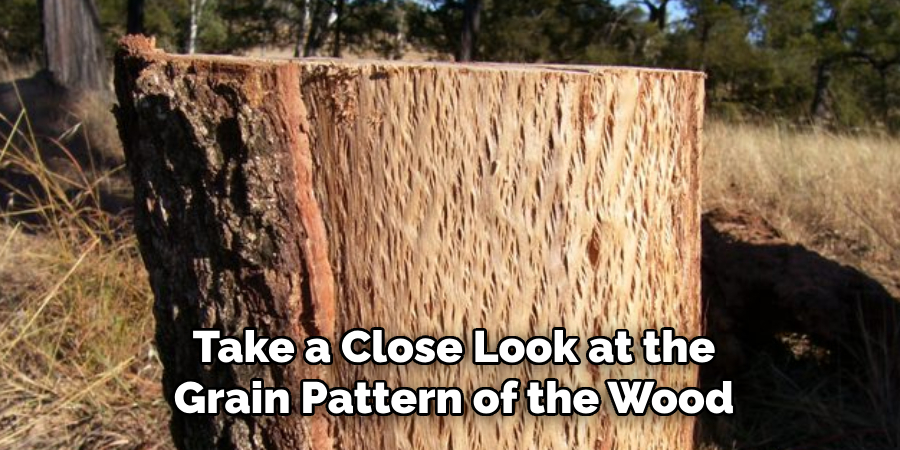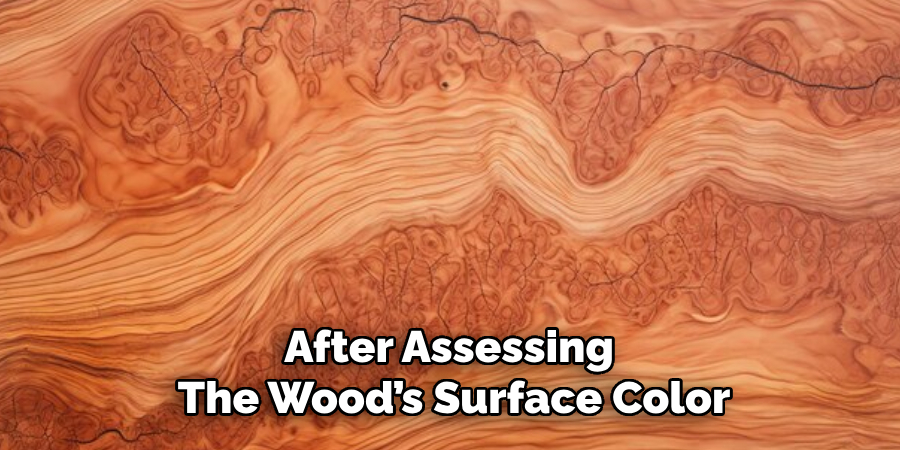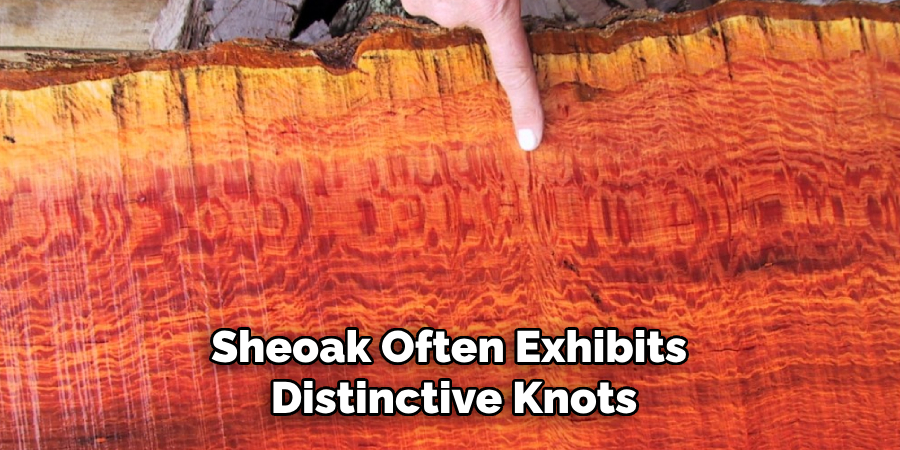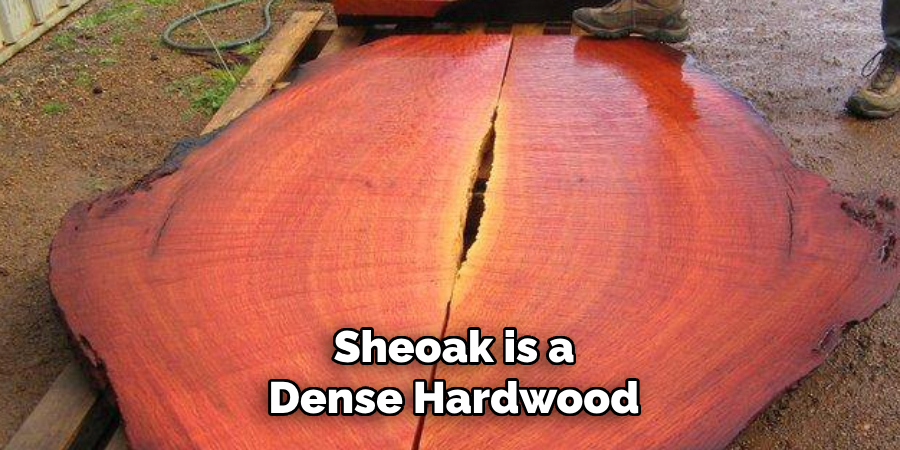Are you curious to learn how to identify Sheoak wood? If you’re a woodworking enthusiast or simply interested in different types of wood, then this guide is for you!
Identifying sheoak wood, renowned for its distinctive characteristics and versatility, can be both an engaging and informative. This species, primarily found in Australia, features unique grain patterns and a rich, warm color, making it a favorite among woodworkers and craftsmen. Understanding the key features, such as its hardness, texture, and specific scent, can aid in distinguishing sheoak from other types of timber. As you continue reading, we’ll dive into the practical steps and techniques you can use to identify sheoak wood.

In this guide, we will explore various methods and tips for accurately identifying sheoak wood, ensuring that you can appreciate and utilize this remarkable material to its fullest potential.
What Will You Need?
Before we dive into the process of identifying sheoak wood, it’s essential to gather a few tools and materials to aid the identification process. Here are some things you may need:
- Visual Reference: It’s always helpful to have images or samples of sheoak wood on hand for comparison purposes.
- Magnifying Glass: A magnifying glass can be helpful in examining more minor details and features of the wood, such as its grain pattern.
- Scratch Test Tool: This can be any sharp object that you can use to make minor scratches on the surface of the wood.
- Smell Test Tool: You can use your sense of smell or even a tiny sandpaper to rub the wood and determine its unique scent.
- Knowledge of Other Types of Wood: Having a basic understanding of other types of wood can aid in distinguishing sheoak from similar-looking species.
Once you have these materials ready, you’re all set to begin the identification process!
10 Easy Steps on How to Identify Sheoak Wood
Step 1: Observe the Colour
Begin by examining the wood’s colour. Sheoak typically has a rich, warm hue that ranges from golden yellow to deeper reddish-brown tones. This distinctive coloring can help you differentiate sheoak from other types of wood. Look for variations in shade across different parts of the piece and any unique streaks or patterns that may be present.
Step 2: Examine the Grain Pattern
Next, take a close look at the grain pattern of the wood. Sheoak is known for its interlocking grain, which can present a wavy or curly appearance. This is often described as having a slightly irregular texture, which adds to its aesthetic appeal. Use your magnifying glass to inspect the grain closely; you might notice fine lines or dots characteristic of sheoak. Identifying these features will help you confirm whether the wood you are examining is indeed sheoak compared to other timber types which may have straighter or less complex grains.

Step 3: Perform the Scratch Test
To further identify sheoak wood, conduct a scratch test on an inconspicuous surface area. Using your scratch test tool, gently apply pressure to create a small scratch. Sheoak wood is known for its hardness, so it requires a bit of effort to leave a mark. The resulting scratch will reveal a lighter color beneath the surface, which can help you confirm its identity. Additionally, take note of the texture of the wood; sheoak’s tightly packed grains will often feel smooth to the touch, enhancing its appeal in woodworking projects.
Step 4: Assess the Texture
The texture of sheoak wood is another essential feature to evaluate. When you touch the surface, it should feel smooth due to its fine grain. However, sheoak can also present variations, featuring areas that may feel slightly rough or uneven, particularly near knots or imperfections. Pay attention to these changes in texture, as they can help differentiate sheoak from other woods that may feel more consistently rough or soft. It’s essential to consider the surface feel and how the wood responds when sanded; sheoak typically sands down to an excellent finish, enhancing its overall appeal in finished projects.
Step 5: Evaluate the Scent
Another unique feature of sheoak wood is its distinct scent. When you lightly sand the surface or simply scratch it, take a moment to assess the released smell. Sheoak has a pleasant, aromatic scent, often described as earthy or nutty, which can be a helpful identifying characteristic. This olfactory cue can set sheoak apart from other wood types that may not possess such a prominent fragrance. Make sure to compare the scent with that of different woods you may be familiar with to reinforce your identification process.
Step 6: Check for Variations in Colour
After assessing the wood’s surface color, it’s crucial to look for any variations that may be present across different sections of the piece. Sheoak can display a range of tones due to its natural properties, including streaks of lighter or darker shades. These color variations can indicate the tree’s specific growth conditions and age. Carefully examine the entire piece, as identifying these subtle differences can further confirm the presence of sheoak wood while enhancing your knowledge of its unique characteristics. Pay attention to any unusual markings or colour shifts, as these can also hint at the wood’s origin and authenticity.

Step 7: Inspect the End Grain
To gain deeper insights into the wood type, turn your attention to the end grain of the sheoak. The end grain pattern can provide significant clues, as sheoak typically features a unique arrangement of growth rings that are distinct and well-defined. Use your magnifying glass to closely observe the rings, which can appear more spaced apart in older trees, indicating the tree’s age and growth conditions. Additionally, the color and texture of the end grain may vary, showcasing flecks or lines similar to those seen on the surface grain. This examination will enhance your ability to identify sheoak and appreciate its intricate beauty accurately.
Step 8: Look for Knots and Imperfections
When identifying sheoak wood, pay close attention to any knots or imperfections within the piece. Sheoak often exhibits distinctive knots that can add character and visual interest to the wood. These knots may vary in size and density, which can also affect the overall strength and workability of the wood. By examining the knots, you can assess their orientation and shape, as sheoak typically has tighter knots compared to other species. Additionally, imperfections such as splits or checks may occur, providing further clues to the wood’s identity. Understanding how these features contribute to the overall aesthetic and function of the wood will enhance your appreciation of sheoak in woodworking projects.

Step 9: Assess the Weight
Next, consider the weight of the sheoak wood. Sheoak is known for being a dense and heavy wood, which can significantly indicate its identity. By lifting the piece, you should notice that it feels considerably weighty compared to lighter woods. This density contributes to she-oak’s durability and affects its performance in various applications such as furniture making or flooring. If you’re comparing multiple types of wood, the weight test can quickly and effectively narrow down your options and confirm whether you’re handling sheoak.
Step 10: Consult Reference Materials
Finally, if you still need to learn about the identity of the wood, consult reference materials such as wood identification guides or online databases. These resources often include detailed photographs, descriptions, and comparisons of various wood types, including sheoak. Engaging with knowledgeable enthusiasts or professionals in woodworking forums can also provide valuable insights and opinions about the wood. Gathering information from multiple sources can strengthen your understanding of sheoak and ensure accurate identification, enriching your woodworking experience.
Following these steps, you can confidently identify sheoak wood and appreciate its unique qualities in your projects.
5 Things You Should Avoid
- Ignoring Color Variations: Sheoak wood can display a range of colors from light tan to dark brown, along with streaks of darker shades. Relying solely on color without examining grain patterns can lead to misidentification.
- Overlooking Grain Patterns: The distinctive grain of sheoak features wavy, interlocking patterns. Only make identification decisions if closely examining these unique characteristics.
- Neglecting to Check Weight: Sheoak is a dense hardwood; its weight can be a helpful identifying feature. Assuming a wood sample is sheoak based solely on appearance can result in mistakes.
- Disregarding Odor: Freshly cut sheoak wood has a slightly sweet smell. Not taking the time to assess the wood’s aroma can lead to inaccurate identification, especially when confused with similar species.
- Failing to Research Common Misidentifications: Some woods, such as certain types of acacia or other hardwoods, can easily be mistaken for sheoak. Failing to familiarise oneself with these common look-alikes can confuse identification efforts.

By avoiding these mistakes and taking the time to conduct thorough research, you can confidently identify sheoak wood.
Conclusion
How to identify sheoak wood requires a careful and systematic approach, taking into account various characteristics such as grain patterns, color variations, weight, and the presence of knots.
By following the outlined steps—observing the wood’s surface, examining the end grain, assessing weight, and consulting reference materials—you can confidently determine whether a piece of wood is indeed sheoak. Additionally, being mindful of common pitfalls, such as overlooking the significance of weight or grain structure, will further enhance your identification accuracy.
Ultimately, a combination of keen observation, research, and hands-on experience will allow you to appreciate the distinct qualities of sheoak and its value in woodworking.
About the Author
Adrian Green, a lifelong woodworking enthusiast, shares his passion for the craft through The Woodenify Blog. With a foundation built on years of hands-on experience in his father’s woodworking shop, Adrian is dedicated to helping others learn and grow in the world of DIY woodworking. His approach to woodworking combines creativity, practicality, and a deep appreciation for the art of building with your own hands. Through his blog, he inspires individuals of all skill levels to embark on their own woodworking journeys, creating beautiful, functional pieces of furniture and décor.
Professional Focus
- Specializes in DIY woodworking projects, from furniture to home décor.
- Provides step-by-step guides and practical tutorials for woodworkers of all skill levels.
- Dedicated to helping readers build confidence and skill through easy-to-follow instructions and tips.
- Passionate about fostering a community of makers who can share, learn, and grow together.
Education History
- University of Craft and Design – Bachelor of Fine Arts (BFA) in Woodworking and Furniture Design
- Woodworking Apprenticeships – Extensive hands-on training with skilled craftsmen to refine carpentry and furniture making techniques.
- Online Courses & Masterclasses – Continued education in advanced woodworking techniques, design principles, and specialized tools
Expertise:
- DIY woodworking, carpentry, furniture making, and home décor projects.
- Creating accessible tutorials and guides for beginner to advanced woodworkers.
- Sharing the joys and satisfaction of woodworking, from raw materials to finished products.
